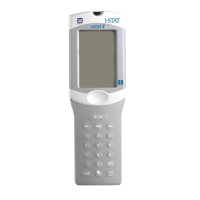Art: 714372-00L Rev. Date: 30-Jul-12 10-5
ARTERIAL PUNCTURE - BLOOD GAS, ELECTROLYTE, CHEMISTRY, AND HEMATOCRIT TESTS
Evacuated Tubes
Evacuated or other blood collection tubes are not recommended for blood gas
analysis.
Syringes and
Anticoagulant
If the sample can be tested in a cartridge immediately, a plain syringe can be
used.
If a cartridge cannot be filled immediately, the sample should be collected in
a pre-heparinized syringe labeled for measurement of electrolytes and ionized
calcium (such syringes contain balanced or low-level heparin).
If manually heparinizing syringes, the heparin-to-blood ratio should not exceed
10 U heparin per milliliter of blood.
Fill syringes to the recommended capacity or use the least amount of liquid
heparin anticoagulant that will prevent clotting. Under filling syringes will
cause higher heparin-to-blood ratios which will decrease ionized calcium
results due to binding. Under filling syringes with liquid heparin will also dilute
the sample causing results to be affected.
i-STAT BNP cartridges require the use of EDTA whole blood or plasma
samples collected in plastic syringes or evacuated tubes containing EDTA.
The use of glass vessels is not recommended because the BNP molecule has
been shown to be unstable in glass tubes. The use of whole blood or plasma
samples containing other anticoagulants such as heparin, oxalate, and citrate
is not recommended.
i-STAT cTnI and CK-MB cartridges require the use of either:
1. heparinized whole blood or plasma samples collected in syringes or
evacuated tubes containing lithium or sodium heparin, or
2. non-heparinized whole blood samples tested within one minute of
drawing from a patient into a plastic syringe or plastic evacuated tube
containing no additives.
The use of whole blood or plasma samples containing other
anticoagulants such as EDTA, oxalate, and citrate will cause
deactivation of the alkaline phosphatase, resulting in decreased cTnI
or CK-MB readings.
i-STAT CHEM8+ cartridges require the use of:
1. whole blood collected in non-heparinized capillary tubes, evacuated
tubes, or syringes, as long as sample is tested immediately upon
draw,
2. heparinized whole blood collected in balanced heparin syringes or
capillary tubes, or
3. heparinized whole blood collected in evacuated tubes containing
lithium or sodium heparin, as long as the tubes are filled to capacity.

